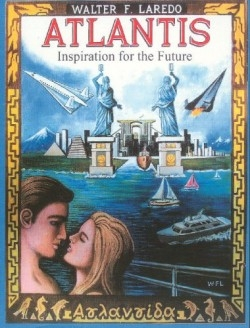Atlantis
Inspiration for the Future
…there occurred violent earthquakes and floods; and in a single day and night of misfortune all your warlike men in a body sank into the earth and the island of Atlantis in like manner disappeared in the depths of the sea.—Plato from Timaeus 360 BCE
A boy exploring the sparsely populated mountain region of Bolivia comes upon a cave full of wonders. In a dream-state he meets the central figures of several world religions along with Isaac Newton and Plato. Each imparts a piece of life wisdom. Seated in a mental transporter known as the Stone of Dreams he merges with the mind of an Atlantean boy and experiences the peak period of that advanced society firsthand eleven thousand years ago. The book includes maps illustrations color plates. An impressive amount of labor went into it.
Social policies are covered. Atlanteans favor common sense and most notably universal health care. Technology and genetics are explored more extensively. The author seems willing to take a stab at any subject as evidenced by the appendix section entitled Answers to the Big Universal Questions. The Bible book of Genesis is corrected: “The theories of creation and evolution are not opposite instead they are complementary.”
A species of alien human-eaters whose public relations techniques resemble those of early Catholic missionaries have a lurid interest in stirring up public opinion against birth control. Laredo’s Atlanteans are identified as predecessors of today’s Nordic peoples. The Incas of Peru are dismissed as the possible source of megaliths such as those at Machu Piccu: “We quickly realized the indigenous people did not build these structures.”
Atlantis is as much a series of serious design proposals as a fantasy tale. Laredo has almost every major American aeronautics firm on his resume. Some of his work endeavors were merged into this project. Over two hundred pages are devoted to engineering drawings of aircraft. Feasibility of implementation goes from very likely functional (two passenger jet thirty passenger jet Halcon fighter aircraft) to pure fancy (horse plane Hypersonic Piggyback plane). Another which could well be feasible is a Cargo Aircraft with Nuclear Propulsion. It depends on exchanges of ocean water twice an hour opening a controversial can of worms. The author was once employed by Argentina’s Comisión Nacional de Energía Atómica; he inserts pro-nuclear energy statements throughout the book.
The exacting detail in the engineering drawings of fighter planes could make foreign governments and U.S. security agencies most eager to read Atlantis. Less experienced aeronautics engineers—or even NASA itself—may glean a few pointers from Walt Laredo. The story portion offers up a sensible idealism but it is a vehicle for the presentation of inventions and is of average literary quality; more a fanciful boy’s adventure than a careful allegory or radical battle cry. This book will provide food for thought to those with a technical inclination.
Disclosure: This article is not an endorsement, but a review. The publisher of this book provided free copies of the book and paid a small fee to have their book reviewed by a professional reviewer. Foreword Reviews and Clarion Reviews make no guarantee that the publisher will receive a positive review. Foreword Magazine, Inc. is disclosing this in accordance with the Federal Trade Commission’s 16 CFR, Part 255.

